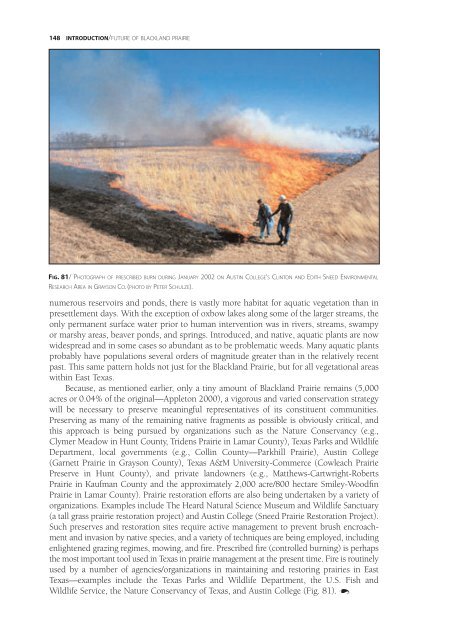ILLUSTRATED FLORA OF EAST TEXAS - Brit - Botanical Research ...
ILLUSTRATED FLORA OF EAST TEXAS - Brit - Botanical Research ...
ILLUSTRATED FLORA OF EAST TEXAS - Brit - Botanical Research ...
You also want an ePaper? Increase the reach of your titles
YUMPU automatically turns print PDFs into web optimized ePapers that Google loves.
148 INTRODUCTION/FUTURE <strong>OF</strong> BLACKLAND PRAIRIE<br />
FIG. 81/ PHOTOGRAPH <strong>OF</strong> PRESCRIBED BURN DURING JANUARY 2002 ON AUSTIN COLLEGE’S CLINTON AND EDITH SNEED ENVIRONMENTAL<br />
RESEARCH AREA IN GRAYSON CO.(PHOTO BY PETER SCHULZE).<br />
numerous reservoirs and ponds, there is vastly more habitat for aquatic vegetation than in<br />
presettlement days. With the exception of oxbow lakes along some of the larger streams, the<br />
only permanent surface water prior to human intervention was in rivers, streams, swampy<br />
or marshy areas, beaver ponds, and springs. Introduced, and native, aquatic plants are now<br />
widespread and in some cases so abundant as to be problematic weeds. Many aquatic plants<br />
probably have populations several orders of magnitude greater than in the relatively recent<br />
past. This same pattern holds not just for the Blackland Prairie, but for all vegetational areas<br />
within East Texas.<br />
Because, as mentioned earlier, only a tiny amount of Blackland Prairie remains (5,000<br />
acres or 0.04% of the original—Appleton 2000), a vigorous and varied conservation strategy<br />
will be necessary to preserve meaningful representatives of its constituent communities.<br />
Preserving as many of the remaining native fragments as possible is obviously critical, and<br />
this approach is being pursued by organizations such as the Nature Conservancy (e.g.,<br />
Clymer Meadow in Hunt County, Tridens Prairie in Lamar County), Texas Parks and Wildlife<br />
Department, local governments (e.g., Collin County—Parkhill Prairie), Austin College<br />
(Garnett Prairie in Grayson County), Texas A&M University-Commerce (Cowleach Prairie<br />
Preserve in Hunt County), and private landowners (e.g., Matthews-Cartwright-Roberts<br />
Prairie in Kaufman County and the approximately 2,000 acre/800 hectare Smiley-Woodfin<br />
Prairie in Lamar County). Prairie restoration efforts are also being undertaken by a variety of<br />
organizations. Examples include The Heard Natural Science Museum and Wildlife Sanctuary<br />
(a tall grass prairie restoration project) and Austin College (Sneed Prairie Restoration Project).<br />
Such preserves and restoration sites require active management to prevent brush encroachment<br />
and invasion by native species, and a variety of techniques are being employed, including<br />
enlightened grazing regimes, mowing, and fire. Prescribed fire (controlled burning) is perhaps<br />
the most important tool used in Texas in prairie management at the present time. Fire is routinely<br />
used by a number of agencies/organizations in maintaining and restoring prairies in East<br />
Texas—examples include the Texas Parks and Wildlife Department, the U.S. Fish and<br />
Wildlife Service, the Nature Conservancy of Texas, and Austin College (Fig. 81). B
















